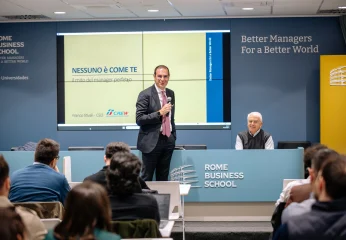The demographic trends in Italy and worldwide

Stop the loss of talents, attract talents from abroad, economic and social costs, trends and proposals in the Rome Business School’s research
Italy, the oldest country in Europe, will lose about 7 million inhabitants, 11% of its total population within the next 50 years, mainly due to the drop of the birth rate which has increased during the pandemic with 10,000 births between this year and 2021, and amount of emigrating young people. A real flight of talents which costs the government 30 billion euros each year, 165 thousand euros per family. It is mainly women who leave the country for other destinations such as the United Kingdom, Germany, France, Switzerland, Spain, Brazil, the United States, Australia and Canada. Internationalizing the higher education system, focusing on the English teaching and on the e-learning are some of the solutions reported by the Rome Business School Report to stem the phenomenon, focusing competencies and knowledges.
The research carried out by the Rome Business School – Research Center has highlighted trends, economic, social costs and proposals related to the phenomenon of youth exodus linked to the aging of the Italian population with reference to the other countries of the world as well.
The following conditions emerged from the study:
182 Graduates left Italy in the last 10 years, about 117 thousand in 2018. The rate of Women are increasing, especially those located in the northern regions of Italy. Destination? United Kingdom, Germany and France, EU, Brasil, USA and Australia among non-European countries
- The analysis of the young people leaving our country confirms that it is a real brain drain. It is difficult to establish the exact number but ISTAT data indicates that only in 2018, 117 thousand Italians left, of which 30 thousand graduates. Almost three out of four Italian citizens who moved abroad are around 25 years old or older and in the last 10 years the young graduates who have left our country have been 182 thousand with an average age of thirty years old.
- Looking at the country’s overall demographic issues, Italy will lose about 6.8 million inhabitants over the next 45 years. A considerable number, which today would amount to a loss of approximately 11% of the total population. Just in 2018 this amounts to 242,353 people enrolled in the Register of Italians Abroad (Aire) of which 53.1% for expatriation, 35.9% for birth, 3.3% for acquisition of citizenship. They are mainly men (55.2%) and young people (40.6% are between 18 and 34 years old) or young adults (35-49 years old, 24.3%), or people in full working age.
- Talents moving to European and non-European destinations; the United Kingdom is the preferred European destination by the younger population which in 2019 welcomed the majority of Italians abroad, with a peak of 25 thousand in 2016. Germany is another favorite destination by Italians, followed by France, Switzerland and Spain which has doubled the number. Among non-European countries, the main destinations for Italian expatriates are Brazil, the United States, Australia and Canada, amounting to total of 18 thousand immigrants.
What is the Italian strategy for growing and attracting young talents?
The development of an international training offer, in English and with the contribution of the e-learning tools. Focusing also on the development of the most requested professional figures now on the market: Digital Marketing managers, Energy Managers and Data Scientists
The key to action to stem the phenomenon of brain drain and attract talents from abroad lies above all in the development of the training offer in English and on the enhancement of e-learning. In this context, it is important to highlight that the training offer in English represents the most demanded and a significant progress has been made in these recent years: in 2013/2014 the courses provided in English were 143 while they have become 398 during the 2018/2019 academic year. A direction which is already involving many Italian Business Schools, which aim at playing an essential role in generating the highest numbers of most qualified profiles and who have the largest market abroad. Among these profiles, according to the Rome Business School, there are digital marketing experts, but also energy managers and legal techs alongside data scientists.
“Business Schools can play a key role in identifying the needs of the world of work and in providing educational support that connects supply and demand – comments the Dean of Rome Business School, Antonio Ragusa – In our case 80% of those enrolled manage to achieve important wage and professional progress, with employment rates of 85% three months after graduation and a 121% of wage increases compared to the pre-master average. Our strength lies in our international profile thanks to partnerships developed all over the world; with 50 partners and a network of 221 multinational companies”
Among the other aspects highlighted by the Research aimed at strengthening the country’s system, is the creation of a tax exemption differentiation system based on the quality of the positions and professional profiles, as well as in line with company demands and needs. A system which can be applied to contrast flows out of the country and as an incentive to keep and attract talents potentially ready to leave the country by enhancing entry level of young graduates; simplifying legal regulations and procedures through the creation of specific entry visas (USA model) and the speeding up of bureaucratic procedures to encourage the circulation of highly qualified human capital in universities and businesses; ensure a more continuous and strategic involvement of the companies-universities / business schools across the training-work chain that takes into account the real professional needs of the market.




